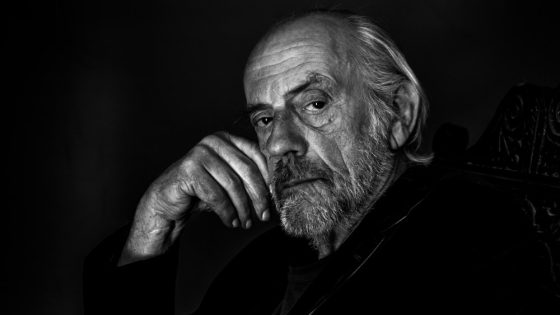One clear thing emerges from Christopher Lloyd’s huge, eclectic body of work: All the characters he embodies become larger than life when he pulls them off the printed page and inhabits them. His latest role, playing silent film legend Fatty Arbuckle’s grandson Larry on “Hacks,” continues that trend and has earned him his first Primetime Emmy nomination (for outstanding guest actor in a comedy series) in 32 years.
In the “Hacks” episode he’s nominated for, Lloyd plays an eccentric, living in a home surrounded by memorabilia and memories — and a pet falcon. Shot on location in the historic, Queen Anne-style Andrew McNally House built in 1887 in Altadena, the nine-bedroom mansion boasts a three-story rotunda and an aviary.
“I’m not looking for strangers; I don’t want people knocking on the door selling magazines, none of that. I am preserving my little island and very happily doing so,” Lloyd says of Larry. “He’s not a social being. He bristles, and if he’s in a situation where he doesn’t have control of things going on, he begins to sputter. He probably grew up in this house and feels safe in it.”
Lloyd in “Hacks” (Jake Giles Netter/Max)
The great character and smart, funny dialogue he got on “Hacks” is old hat for Lloyd, who made his mark on “Taxi” back in the late 1970s and early 1980s. On “Taxi,” his Reverend Jim Ignatowski was a spaced-out cabbie with a gigantic heart and uncomplicated mind, who liked drugs a little more than casually. Although he won two Emmys for the role, sitcoms in general were not a path he originally wanted to follow.
“There was a kind of a stupid bias in New York in the early ’60s or mid-’60s that it was kind of selling your soul to go to Hollywood and do a sitcom,” he tells Variety. “Surely, if you are a serious actor, a real actor, you don’t go looking for sitcoms.” He was a theater guy but ventured to Los Angeles anyway — “but with a little bit of that attitude.” Once in L.A., he apprised his agent of his attitude about sitcoms, who set him up on sitcom auditions every once in a while, just to meet casting directors. “You never know down the road when that might turn out to be important,” Lloyd recalled his agent saying. One of those times led to his gig on “Taxi.”
“I dug the role just reading it,” he remembers. Before he was offered the part in its second season, he went to the set to watch the actors working together. “I thought, these guys are great. In New York, you’re always hearing about the ideal theater [which] is to create an ensemble. And I thought, ‘It’s before my eyes right here. It’s ideal. And I’ve never changed my feelings about that. I just thought it was an incredible company. I was delighted to be a part of it. I thought, ‘This isn’t going sideways. This is a good thing. So I got over my reservations about sitcoms quickly,” he adds with grin. “I mean, I don’t have much to complain about.”

Lloyd as Reverend Jim Ignatowski on “Taxi”
CBS via Getty Images
Reverend Jim was without a doubt a unique character. Always disheveled, stoned and clueless because of it. The minute he opened his mouth and said something — anything — you couldn’t help laugh. (You got some free time on your hands? Find clips of Jim scenes on YouTube with his “Taxi” co-stars Danny DeVito, Judd Hirsch, Marilu Henner, Tony Danza, Andy Kaufman and Jeff Conaway. You won’t be sorry you did.)
“I just kind of felt like I knew the guy,” says Lloyd. “I understood what he was about. At that time, there were people like him out on the street. So I just observed them and my feelings about it, and it worked. … A lot of that performance came out of the freedom I felt working with that cast and the great writing team. They made it easy.”
Jim was just the beginning of a stream of character types Lloyd played that share something very unique in common: to this day, they make great Halloween costumes. Think about: Reverend Jim on “Taxi,” Doc Brown in the “Back to the Future” trilogy, Judge Doom in “Who Framed Roger Rabbit?,” Uncle Fester in “The Addams Family” movies and Klingon Commander Kruge in “Star Trek III: The Search for Spock.”

Michael J. Fox and Lloyd in “Back to the Future” (Universal)
Lloyd is humbled by the longevity of the love for Doc Brown, the brilliant, benevolent, oddball inventor of the flux capacitor (“great Scott!”). “I’ve done my share of work, and nothing compares to the way ‘Back to the Future’ is ingrained in people’s minds,” he says. “It’s phenomenal. Every day practically — and certainly I go to Comic-Cons — people come up and say, ‘You made my childhood.’ And another reference equal to that, where ‘Back to the Future’ fills the gap in a lot of lives of young people, who have gone on to become doctors, scientists and what have you. So a lot of gratitude and I feel real good about that. I feel very fortunate to be part of that.”
Uncle Fester in the “Addams Family” films was yet another character that had special meaning to him. He tells of how, when he was a kid, his family subscribed to the New Yorker magazine. He never read the articles at the time; he just looked at the cartoons. And very often there’d be a Charles Addams cartoon and one that would feature Uncle Fester along with the rest of the family.
“I loved that,” says Lloyd. “It was mischief about Uncle Fester and not evil. He just could play around a little bit. And then, that period of my life passed and decades later, I get a call, would I like to be Uncle Fester in a film? What are the odds? It was very exciting to be able to play the character that I loved when I was a kid.”

Lloyd played the Klingon Commander Kruge in “Star Trek III: The Search for Spock.”
Courtesy of CBS
Back then, that kid would also probably never have believed that someday he’d be an action figure, but Lloyd is that too. Trekkies out there know what I’m talking about — the foot-tall Klingon Commander Kruge doll is a spittin’ image of Lloyd. From the moment “The Search for Spock” director Leonard Nimoy asked him to don the character’s prosthetic forehead, evil brows and goatee, a supervillain was instantly born.
“I’d come to the Paramount Studio at four in the morning to get that makeup put on — the way it built up my forehead — and then the costume. How can you not feel like you’re the character when you do all that?” he asks. “I loved it. I tried to find what is it about this guy that I could relate to an audience whereby they will feel something about themselves in this guy — even if it’s somebody you don’t want at your dinner table, you know? It doesn’t change his undesirable traits, but I want the audience to feel they’re not engaged with somebody off a different planet. They’re engaged with somebody they can talk to.”
Source Agencies




